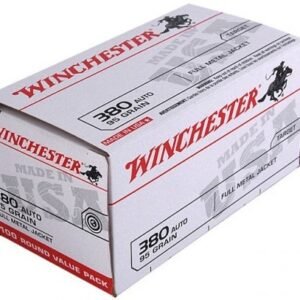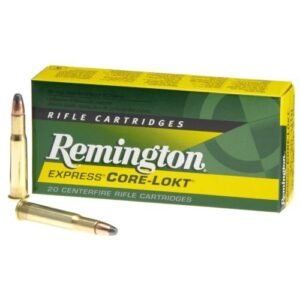Description
buy 30 30 ammo
The 30-30 ammo Winchester/.30 Winchester Center Fire cartridge was first marketed in 1895 for the Winchester Model 1894 lever-action rifle. The .30-30 (thirty-thirty), as it is most commonly known, and the .25-35 were offered that year as the USA’s first small-bore sporting rifle cartridges designed for smokeless powder. Sixty years after its introduction, in 1955, it was surpassed by the smaller bore .243 Winchester cartridge with more powerful and accurate ballistics yet similar recoil, but the .30-30 Winchester remains in widespread use even today.
The .30 Winchester Smokeless first appeared in Winchester’s catalog No. 55, dated August 1895. When chambered in the Winchester Model 1894 carbine and rifle, it was also known as .30 Winchester Center Fire or .30 WCF. When the cartridge was chambered in the Marlin Model 1893 rifle, rival gunmaker Marlin used the designation .30-30 or .30-30 Smokeless. The added -30 stands for the standard load of 30 grains (1.9 g) of early smokeless powder and is based on late-19th century American naming conventions for black powder-filled cartridges. Both Marlin and Union Metallic Cartridge Co. also dropped the Winchester appellation, as they did not want to put the name of rival Winchester on their products.[4]
The modern designation of .30-30 Winchester was arrived at by using Marlin’s variation of the name with the Winchester name appended as originator of the cartridge, but .30 WCF is still seen occasionally. This designation also probably serves to avoid consumer confusion with the different, yet similarly shaped .30-40 Krag, which has been referred to as .30 US and .30 Army.
30-30 ammo for sale
Characteristics and use
In Canada and the U.S., the cartridge has also been used on moose, caribou, and pronghorn. Modern opinions in Canada on its suitability for moose are mixed. Paul Robertson, a Canadian hunting firearms columnist, says, “Too many moose have been taken with the [ 30 30 ammo] to rule it out as good for this purpose, as well.” In both Canada and the U.S. it has a long history of use on moose. It is generally agreed that the .30-30 is not a good choice for hunters who wish to shoot animals at longer ranges. The cartridge, with flat- or round-nosed bullets, does not meet minimum energy standards required for moose hunting in Finland, Norway, or Sweden. Hunting technique and style, as well as law and culture, dictate cartridge choices.Thor Strimbold, a Canadian who has made more than 20 one-shot kills on moose with a 30-30, advises most moose hunters to use more than minimal power if they can handle the recoil.While the .30-30 is legal for hunting moose in Newfoundland, Canada, provincial game authorities do not recommend its use.
One of the primary reasons for the .30-30’s popularity amongst deer hunters is its light recoil. Average recoil from a typical 150-grain load at 2,390 feet per second (730 m/s) in a 7.5 lb (3.4 kg) rifle is 10.6 foot-pounds (14.4 J) of felt recoil at the shooter’s shoulder, about half that of a comparable rifle chambered for the .30-06 Springfield.However, the .243 Winchester offers more muzzle energy and far greater downfield terminal energy than the .30-30 with similarly light recoil.
MORE INFORMATION
| SKU | 736100100 |
|---|---|
| Caliber | .30-30 Win |
| MPN | 27820CSE |
| UPC | 496461016450 |
| Brand | Remington |





Reviews
There are no reviews yet.